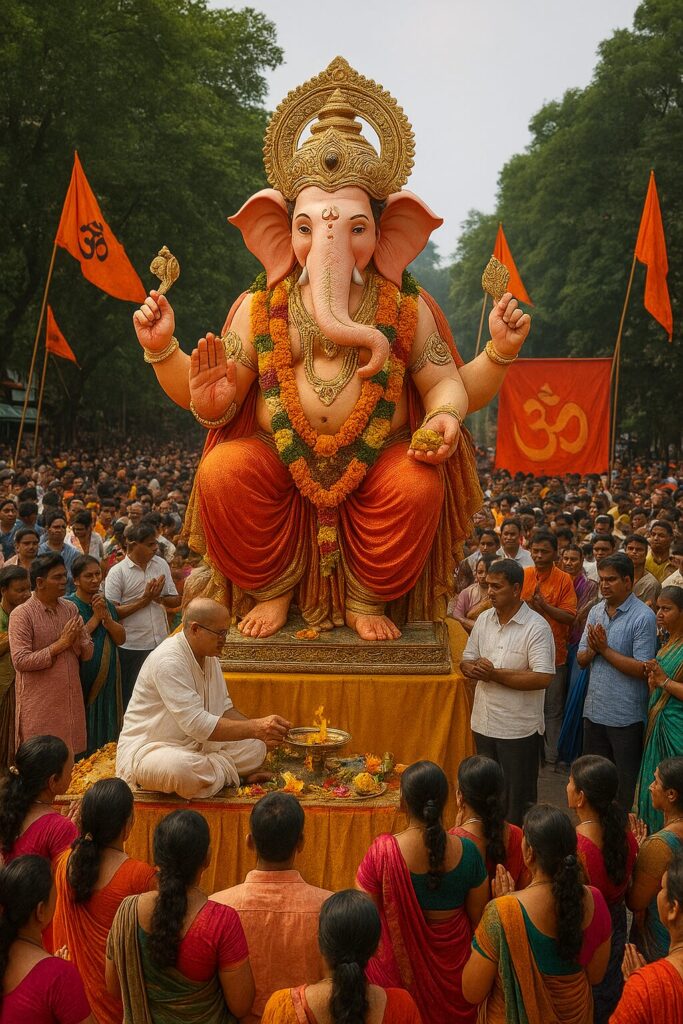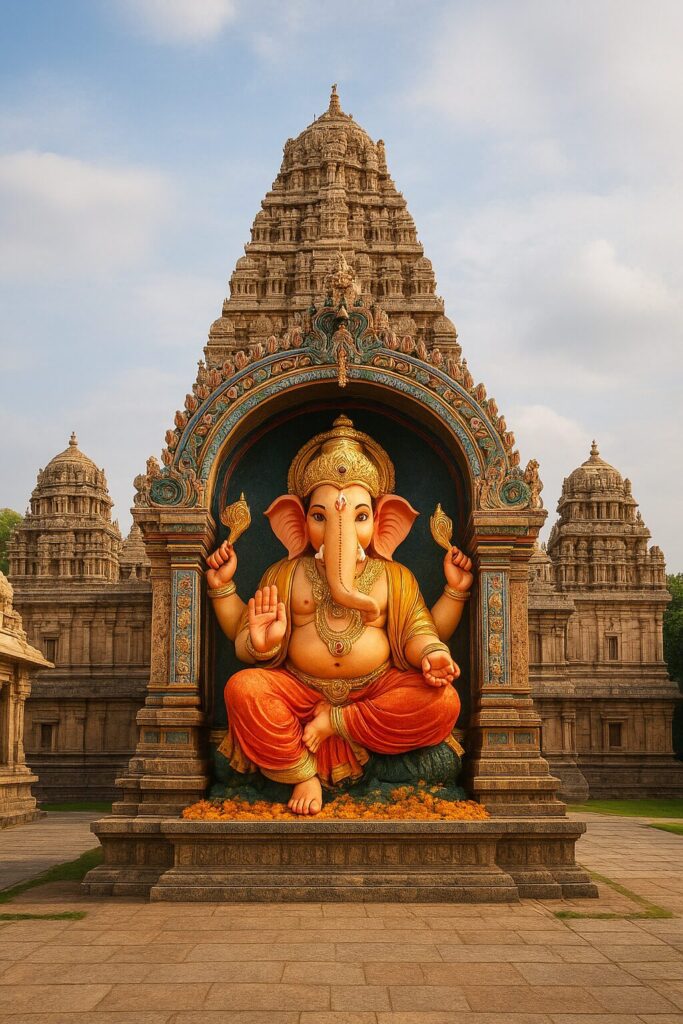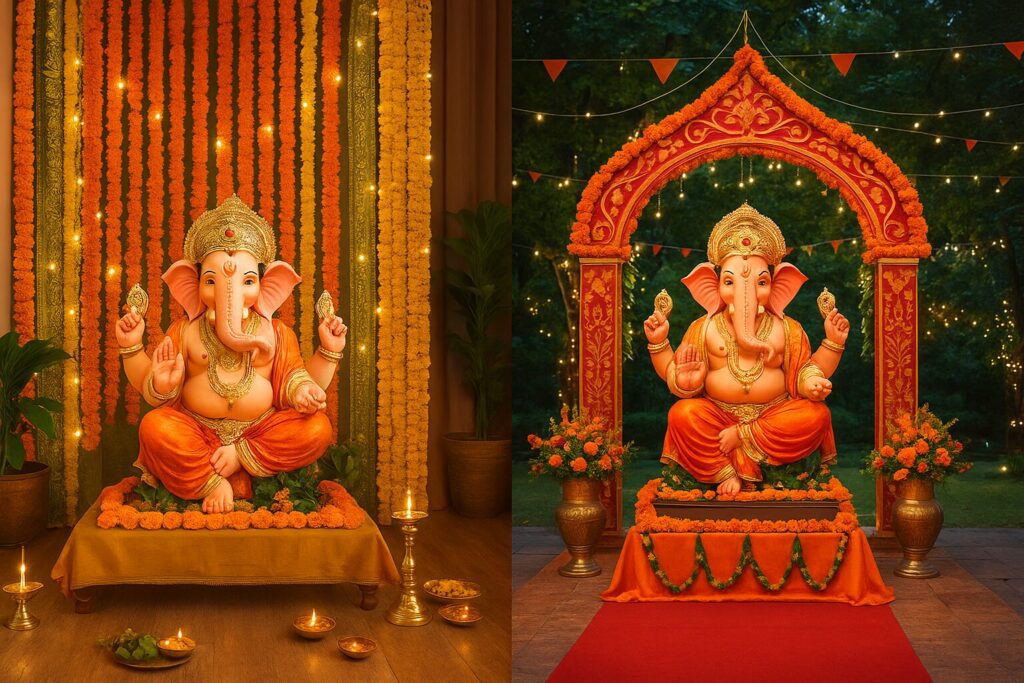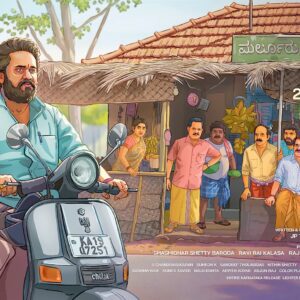Get ready, Ganpati vibes! This year’s Ganesh Chaturthi is going to be the biggest, most vibrant, joyous, important, and Instagram-worthy celebration ever. Spoiler alert: we will be involved deep into the muhurt, tithi, rituals, stories, safety tips, and quotes worth sharing. Imagine paper lanterns, lots of sweet laddus, modaks, and the grand arrival of your Bappa (Lord Ganesha)—all amid a festive and eco-friendly atmosphere. Whether you are decorating your living room or the entire house, planning a puja party, or looking for great decor inspiration, this blog is here to help. Stay tuned—by the end, you will be festival-ready, post-perfect and full of Ganpati-love!

- “26 or 27 August? Ganesh Chaturthi 2025 Date Guide”
This confusion arises from two time systems: Chaturthi Tithi (lunar calendar) and Udaya Tithi (sunrise-based). In 2025, Chaturthi Tithi begins at 1:54 pm on August 26 and ends at 3:44 pm on August 27. Nevertheless, according to the sunrise calculation, the festival is celebrated on August 27, especially in Maharashtra. In Mumbai, the midday puja muhurta is around 11:24 am to 1:55 pm; similarly, in Karnataka, Bengaluru, it is from 11:07 am to 1:36 pm. Ganpati Sthapana ideally takes place during this midday muhurta.
Ganesh Chaturthi 2025 Visarjan Date:
According to Drik Panchang, Ganesh Visarjan Date is 6th September 2025. On Anant Chaturdashi Tithi Timings Is on 6th September. Tithi Begins – 03=12 AM and Tithi Ends 7th September – 01=41 AM. Means usually on 6th September 2025, Full Day Time up to Midnight 12=00. PM.
- Rituals & Celebration Ideas:
.Ganesh Chaturthi rituals are full of colours, devotion and a sense of community. Start with the installation of Lord Ganapati idol—place it in home or pendals at public places around the entrance of your home or apartment, and install the idol on a decorated mantap. Start by lighting diyas, sprinkling water, and chanting Ganapati mantras, such as “Vakratunda Mahakaya…”. During the midday muhurat (approximately 11 am to 1:40 pm), perform aarti, offer modaks, sweet laddus, flowers, coconut and chant shlokas to seek Bappa’s blessings and don’t forget to pray to Bappa by doing namaskar.
Be a little playful: Host a modak or sweet laddu making party, erect a clay idol in your home, and decorate it with natural rangoli, seed idols or paper pulp Ganesha. Make it social— and at the end of the festival, organise a community immersion tank, so that the idols can be immersed in an environmentally sensitive manner. Create a DIY photo corner with eco-prop frames—instantly add festive posters! Play bhajans, stream Ganesh-themed playlists, or start a virtual puja if your loved ones are far away. How does it feel now? A union of devotion, creativity and stillness.
3) Lord Ganesha: Names & Blessings

Our dear Bappa goes by many names as Ganapati, Ganesha, Vinayaka, Vighnaharta (remover of obstacles), Lambodara, Vakratunda, Gajanana, and Chaturbhuja. Eakdanta (Ekdanta), Astavinayaka, Mahakaya, Pillaiyar. Each name carries blessings—wisdom, success, protection, creative power. Address him as Vighnaharta when seeking problem-solving, as Lambodara for abundance, or Vakratunda for new beginnings. His presence fills homes with peace, prosperity, clarity, and good fortune. No wonder we invite him before any big venture—studies, weddings, new ventures—knowing he clears obstacles in the path.
4) Lord Ganesh: Birth History:
The heartwarming legend: Goddess Parvati sculpted Ganesha from sandalwood or turmeric paste while Shiva was away. Tasked with guarding her door, he unknowingly denied Lord Shiva entry. Infuriated, Shiva severed his head. When Parvati’s grief shattered Mount Kailash, Shiva swiftly replaced the head with that of a divine elephant head, granting him life and status among gods. Thus, Ganesha—elephant-headed, wise lucky guy—was born.
Beyond the myths, the festival broadened its reach to the masses under the leadership of Lokmanya Bal Gangadhar Tilak in 1893. He transformed the private family puja into a massive public festival to unite people with Indian pride during the freedom struggle.।
Now, our exuberant arrangements of pandals, public darshans and grand immersion processions, especially in Maharashtra, echo Tilak’s vision. Every time Ganesha comes, he blesses our homes as well as our heritage and unity.
5) Ganesh Festival: Wishes, Quotes, Messages:
Share the love with these snazzy Ganesh Chaturthi wishes:
- “Ganpati Bappa Morya! May your path be obstacle-free and filled with modaks galore.”
- “Wishing you wisdom & joy—happy Ganesh Chaturthi!”
- “Bappa’s blessings landing on you—be destined for success & sweetness.”
- “May Lord Ganesha shower you with love, luck, and unlimited laddoos!”
6) Decoration: Indoor & Outdoor, Setup, Lighting, Social Events :

At your home or neighborhood for Ganpati with these dazzling ideas:
Indoors: Use mango leaf garlands as natural decorations, decorate your place of worship with marigold flowers, and string fairy lights around your idol. Use LED string lights or eco-friendly diyas for warm light—gentle on the eyes and electricity bills. Ganesha cutouts made of colourful cloth or paper mache can make for even better photo opportunities!
Outdoors: Place Ganesha idols in a small temple outside your home balcony or garden. Decorate with bamboo arches and jute tassels, scatter flower petals around the idols, and light earthen diyas for ambiance during the evening aarti. Organize a community Ganesh milan—invite neighbors, distribute sweets, sing bhajans, and share eco-friendly tips. In Bengaluru, Karnataka, huge public workshops even allow people to create their own eco-friendly idols—a great way to build bonds and maintain tradition.
Pandal-like decorations combine creativity with devotion and sustainability in every light and petal.
7) Eco-Friendly Ganesh Murthy:
This year, go eco-friendly—and there’s a good reason! Instead of plaster of Paris idols, make idols out of shadu mati clay, terracotta, red clay, or papier-mache—these dissolve quickly and won’t harm water bodies.
Some idols even have seeds—after immersion, they sprout and become plants! In cities like Mumbai, Ganesha idols are being made out of clay as well.
Bonus: You’ll get celebrity-TikTok-worthy for taking care of the planet while celebrating tradition.
8) Rich & Pilgrim Temples of Lord Ganapati in India:

India has many more historic Ganpati temples. Maharashtra is full of temples, one of the eight revered Ashtavinayakas, is known to provide peace to the troubled mind, there is a Chintamani temple in this place. In Mumbai, during the Lalbaugcha Raja festival, devotees come to see the “Navsacha Ganpati” and pray to fulfill their wishes, almost more than 15 lakh devotees come daily. In South India, vibrant public pandals and traditional temples like Khairtabad Ganesh in Hyderabad also offer spectacular darshan to devotees. These pilgrimage sites are a fusion of spiritual depth and cultural grandeur.
9) Best Places to See Public Ganesh Sightings & Decor in India:
For show-stopping Ganpati decor, Maharashtra and Karnataka steal the limelight.
In Chabbi in North Karnataka, one can see red-sindhoor idols with unique iconography. These attract peoples from Belgaum and beyond. And in Mumbai in Maharashtra, and Bangalore in Karnataka, idols of Ganapati Bappa made by different ideologies are placed in public pendals, and lakhs of people come to see them. organizers make huge clay statues (around 50-61 feet tall) in Bhubaneswar and arrange week-long cultural programs under decorated umbrellas pendals.
Truly, India’s Ganpati decoration game is bold and breathtaking.
10) Precaution & Safety Measures :
While Ganesh Chaturthi is pure joy, a pinch of safety makes it worry-free:
Fire & Lights: If using fairy lights or bulbs, go for LEDs—they’re cooler and efficient. Keep cords and lights away from Dry flowers or cloth. Avoid overloading sockets; consider power-strips with surge protection.
Diyas and Candles: Use sturdy earthen or brass diyas and keep them in stable holders. Never leave them unattended, especially near kids or pets.
Crowd Safety: At public pandals, stay attentive to emergency exits and avoid clogging narrow entryways during visarjan.
Water & Visarjan: Use controlled immersion tanks or home containers to minimize pollution. If immersing in public water bodies, do it early and smoothly—avoid rushing and jostling.
Modaks & Food: Ensure your sweets are prepared hygienically. Keep them covered to avoid flies, and handle with clean hands.
COVID-wise (if still relevant): Offer hand-sanitize stations, encourage masks indoors, and keep small gatherings for vulnerable visitors.
Conclusion :
Ganesh Chaturthi 2025 promises a joyful blend of tradition, creativity, and consciousness. Whether you’re lighting up your home altar, hosting community aartis, or decorating with eco-friendly flair, let every moment be sacred and spirited. From knowing the right muhurt to sharing sharable quotes and safeguarding celebrations with care—this guide has your back. Here’s to Bappa showering you with wisdom, abundance, and beautiful beginnings. Ganpati Bappa Morya—may every step be obstacle-free and every heart overflow with blessings!
FAQs:
Q.1: Why is Ganesh Chaturthi celebrated on August 27, not 26?
Ans: The Chaturthi Tithi spans Aug 26 (1:54 PM) to Aug 27 (3:44 PM). Most regions observe it based on sunrise—the Udaya Tithi—making Aug 27 the festival date.
Q.2: What’s the best time for Ganapati Sthapana?
Ans: The Madhyahna Muhurat (11 AM – 1:40 PM) is considered most auspicious for idol installation and puja.
Q.3: How can I make eco-friendly Ganpati murthy?
Ans: Use clay like Shadu Mati, terracotta, red soil, or paper-mache. You can also embed seeds to grow plants post-visarjan and avoid Plaster of Paris idols.
Q.4: Where should I visit to experience grand public Ganpati?
Ans: Head to Mumbai for Lalbaugcha Raja, Bengaluru for eco-friendly workshops, Bhubaneswar for huge clay idols, or Chabbi (North Karnataka) for distinctive red-sindhoor idols.
Closing:
Here’s to a Ganpati celebration overflowing with colors, devotion, eco-choices, and safety—worthy of sharing, cherishing, and returning to year after year!







